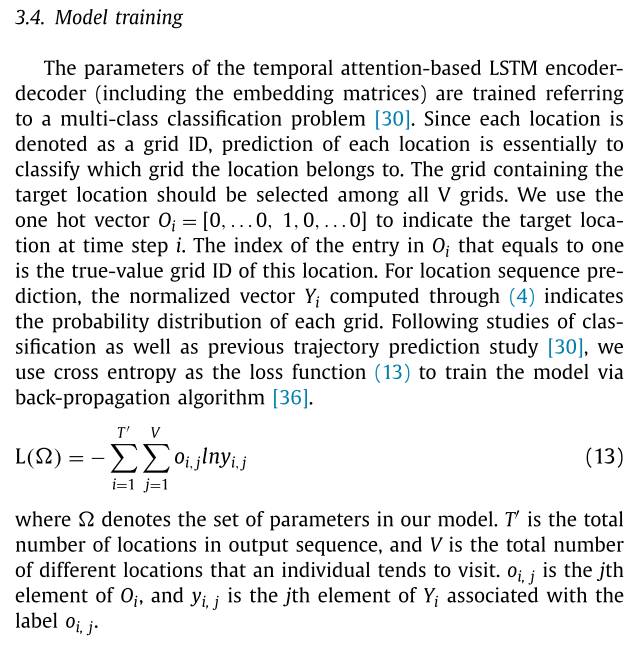
多标签分类的CrossEntropyLoss到底需不需要One-Hot编码
有两个class,每个class有两个dimension,10.50.511& 0.5\\0.5&110.50.51是他未经过softmax处理的raw logit,label是10[1,0]10,求一下loss,用CrossEntropyLoss。
个人主页:https://yang1he.gitee.io
干货会越来越多的,欢迎来玩
多标签分类的CrossEntropyLoss到底需不需要One-Hot编码
今天看文献发现了这个问题,还是基础不牢,查了一下午资料才搞懂。不过发现了好多其他的小点,比较方便用。
问题描述
在读某篇文章时,看到这样描述

标签用的One-Hot编码,看自己的源码,有点奇怪
loss = nn.CrossEntropyLoss()
loss=loss(input,label)
label直接用的一个
c
l
a
s
s
×
1
class\times1
class×1的一个向量啊,并没有One-hot(如果One-Hot,那我用的应该是
c
l
a
s
s
×
类别数
K
class\times 类别数K
class×类别数K的一个向量),CrossEntropyLoss是多分类的损失函数吗,这个class是指的多分类的"多",我错了吗?
先说结论:都没错,只不过公式用One Hot,但是
torch框架下nn.CrossEntropyLoss()是不需要one hot编码的。
求证过程
其实只是要个结果上面就可以了,下面可能有点啰嗦,但是愿意看的话,散乱的小知识还蛮多的。
官网描述
首先看一下官网的描述:
torch.nn.CrossEntropyLoss(weight=None, size_average=None, ignore_index=- 100, reduce=None, reduction=‘mean’, label_smoothing=0.0)
The input is expected to contain the unnormalized logits[^1] for each class (which do not need to be positive or sum to 1, in general). input has to be a Tensor of size (C) for unbatched input, (minibatch,C) or (minibatch,C,d1,d2,…,d**K) with K≥1 for the K-dimensional case. The last being useful for higher dimension inputs, such as computing cross entropy loss per-pixel for 2D images.
[logit, logistic和sigmoid的区别 - 知乎 (zhihu.com)](https://zhuanlan.zhihu.com/p/358223959#:~:text=The (logit) vector of raw (non-normalized) predictions that,typically become an input to the softmax function.)
没有提到One-hot编码的事情,但是明白了一个比较重要的小细节如上。并且提出一个例子
# Example of target with class indices
loss = nn.CrossEntropyLoss()
input = torch.randn(3, 5, requires_grad=True)
target = torch.empty(3, dtype=torch.long).random_(5)
output = loss(input, target)
output.backward()
# Example of target with class probabilities
input = torch.randn(3, 5, requires_grad=True)
target = torch.randn(3, 5).softmax(dim=1)
output = loss(input, target)
output.backward()
这个例子也只是说label可以用含有更多信息的概率值。
其次是学了一套方法,生成哑变量与哑变量(或者叫one-hot编码)的回溯。
#生成one-hot编码
import torch.nn.functional as F
target = F.one_hot(torch.empty(3, dtype=torch.long).random_(5), num_classes=5) # n为类别数
#one-hot编码回溯 用torch.full
target = autograd.Variable(torch.LongTensor([1, 0, 4]))
labels = torch.full(size=(N, C), fill_value=0)
labels.scatter_(dim=1, index=torch.unsqueeze(target, dim=1), value=1)
print('labels is {}'.format(labels))
"""
labels is tensor([[0., 1., 0., 0., 0.],
[1., 0., 0., 0., 0.],
[0., 0., 0., 0., 1.]])
"""
没找到能解答我疑惑的,可能是我对CrossEntropyLoss的理解不够透彻,自己出了个小例子来计算。
CrossEntropyLoss定义,以及手撕题
有两个class,每个class有两个dimension, [ 1 0.5 0.5 1 ] \left[\begin{array}{} 1& 0.5\\ 0.5&1 \end{array}\right] [10.50.51]是他未经过softmax处理的raw logit,label是 [ 1 , 0 ] [1,0] [1,0],求一下loss,用CrossEntropyLoss
解
C r o s s E n t r o p y L o s s = l o g S o f t m a x + N L L L o s s CrossEntropyLoss=logSoftmax+NLLLoss CrossEntropyLoss=logSoftmax+NLLLoss
所以,为了方便理解,先讲一下Logsoftmax、以及NLLLoss做一个铺垫,
Logsoftmax定义:
f
i
(
x
)
=
l
o
g
(
e
(
x
i
)
∑
e
x
i
)
f_i(x)=log(\frac{e^{(x_i)}}{\sum e^{x_i}})
fi(x)=log(∑exie(xi))
就是先取softmax再log,接着是NLLlloss:
f
(
x
,
y
)
=
−
1
N
∑
x
i
∗
y
i
f(x,y)=-\frac{1}{N}\sum x_i*y_i
f(x,y)=−N1∑xi∗yi
NLLLoss得到损失。
x
x
x和
y
y
y分别代表input和label,N带表的是你的classes
真懂了吗,解这个计算题
有两个class,每个class有两个dimension, [ 1 0.5 0.5 1 ] \left[\begin{array}{} 1& 0.5\\ 0.5&1 \end{array}\right] [10.50.51]是他未经过softmax处理的raw logit,label是 [ 1 , 0 ] [1,0] [1,0],求一下loss,用CrossEntropyLoss
解:套公式;自己先手算下哈
step1:计算logsoftmax
f
i
(
x
)
=
[
l
o
g
(
e
1
e
1
+
e
0.5
)
l
o
g
(
e
0
.
5
e
1
+
e
0.5
)
l
o
g
(
e
0.5
e
1
+
e
0.5
)
l
o
g
(
e
1
e
1
+
e
0.5
)
]
=
[
−
0.9471
−
0.4741
−
0.4717
−
0.9471
]
f_i(x)=\left[\begin{array}{} log(\frac{e^1}{e^1+e^{0.5}}) & log(\frac{e^0.5}{e^1+e^{0.5}})\\ log(\frac{e^{0.5}}{e^1+e^{0.5}})&log(\frac{e^1}{e^1+e^{0.5}}) \end{array}\right]\\=\left[\begin{array}{} -0.9471& -0.4741\\ -0.4717&-0.9471 \end{array}\right]
fi(x)=[log(e1+e0.5e1)log(e1+e0.5e0.5)log(e1+e0.5e0.5)log(e1+e0.5e1)]=[−0.9471−0.4717−0.4741−0.9471]
step2:算NLLloss
首先,label给的不是one-hot,如果分两步算的话,需要先one-hot编码,label就成了
[
0
1
1
0
]
\left[\begin{array}{} 0&1\\ 1&0 \end{array}\right]
[0110],然后
L
o
s
s
=
−
1
2
(
[
−
0.9471
,
−
0.4741
]
[
0
1
]
+
[
−
0.4741
,
−
0.9471
]
[
1
0
]
)
=
0.4741
\begin{aligned} Loss&=-\frac{1}{2}\left([-0.9471,-0.4741]\begin{bmatrix} 0 \\ 1 \end{bmatrix}+[-0.4741,-0.9471]\begin{bmatrix} 1 \\ 0 \end{bmatrix} \right)\\&=0.4741 \end{aligned}
Loss=−21([−0.9471,−0.4741][01]+[−0.4741,−0.9471][10])=0.4741
算对了吗同志?
注意到了吗,这里是先做的one-hot编码
因此那,本质上只是用Torch的代码的时候,他帮你做了onehot编码,所以你可以忽略这一步。
最后:
CrossEntropyLoss 的完整定义:
loss
(
x
,
y
)
=
−
∑
i
=
1
C
y
i
log
(
softmax
(
x
)
i
)
\begin{equation} \text{loss}(x, y) = -\sum_{i=1}^{C} y_i \log(\text{softmax}(x)_i) \end{equation}
loss(x,y)=−i=1∑Cyilog(softmax(x)i)
其中,
C
C
C 是分类数,
y
i
y_i
yi 表示样本
x
x
x 的真实标签在第
i
i
i 个类别上的概率,
softmax
(
x
)
i
\text{softmax}(x)_i
softmax(x)i 表示样本
x
x
x 在第
i
i
i 个类别上的预测概率。
更多推荐
 已为社区贡献1条内容
已为社区贡献1条内容








所有评论(0)